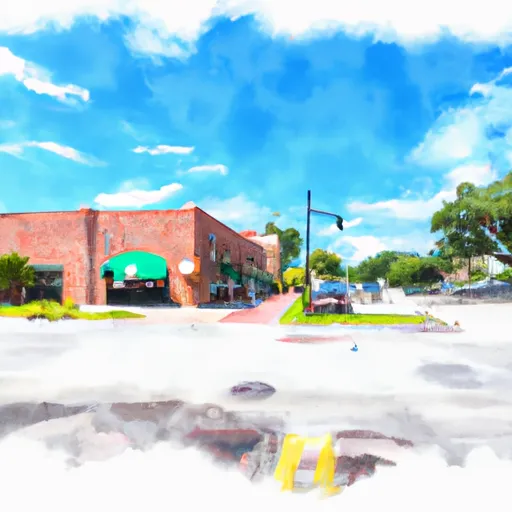-
 Snoflo Premium
Snoflo Premium
Get unlimited access to all our content
With no Ad interruptions! - Start Your Free Trial Login with existing account
Mayo
Eden Index
Climate
7.5
•
Recreation
3.5
•
Community
2.1
•
Safeguard
4.8/10

Mayo is a charming small town situated in Lafayette County, Florida. The town experiences a humid subtropical climate, characterized by hot, humid summers and mild winters. Summer temperatures can reach highs in the 90s°F (32-35°C), while winter temperatures average around 60°F (15°C). Rainfall is evenly distributed throughout the year, with an annual average of around 50 inches (127 cm).
Hydrologically, the region is abundant in natural springs and rivers. The Suwannee River, a prominent waterway, borders Mayo to the east, providing opportunities for water activities such as boating, fishing, and kayaking. Numerous freshwater springs, including Lafayette Blue Springs and Troy Spring State Park, offer refreshing swimming areas and picturesque landscapes.
Outdoor recreation is abundant in Mayo, with ample opportunities for hiking, camping, and wildlife observation. The Lafayette Blue Springs State Park offers well-maintained trails, picnic areas, and camping facilities. The nearby Suwannee River State Park provides access to the Florida National Scenic Trail, which stretches over 1,000 miles (1,600 km) through the state.
Overall, Mayo's inviting climate, hydrological features, and diverse outdoor recreation opportunities make it an attractive destination for nature enthusiasts and those seeking outdoor adventures.
What is the Eden Index?
The Snoflo Eden Index serves as a comprehensive rating system for regions, evaluating their desirability through a holistic assessment of climate health, outdoor recreation opportunities, and natural disaster risk, acknowledging the profound impact of these factors on livability and well-being.
Climate Health Indicator (CHI): 7.5
Mayo receives approximately
1383mm of rain per year,
with humidity levels near 89%
and air temperatures averaging around
20°C.
Mayo has a plant hardyness factor of
8, meaning
plants and agriculture in this region tend to thrive here all year round.
By considering the ideal temperature range, reliable water supplies, clean air, and stable seasonal rain or snowpacks, the Climate Health Indicator (CHI) underscores the significance of a healthy climate as the foundation for quality living.
A healthy climate is paramount for ensuring a high quality of life and livability in a region, fostering both physical well-being and environmental harmony. This can be characterized by ideal temperatures, reliable access to water supplies, clean air, and consistent seasonal rain or snowpacks.
Weather Forecast
Streamflow Conditions
Suwannee
Area Rivers
Suwannee
Snowpack Depths
Suwannee
Reservoir Storage Capacity
Suwannee
Groundwater Levels
Recreational Opportunity Index (ROI): 3.5
The Recreational Opportunity Index (ROI) recognizes the value of outdoor recreational options, such as parks, hiking trails, camping sites, and fishing spots, while acknowledging that climate plays a pivotal role in ensuring the comfort and consistency of these experiences.
Access to outdoor recreational opportunities, encompassing activities such as parks, hiking, camping, and fishing, is crucial for overall well-being, and the climate plays a pivotal role in enabling and enhancing these experiences, ensuring that individuals can engage in nature-based activities comfortably and consistently.
Camping Areas
| Campground | Campsites | Reservations | Toilets | Showers | Elevation |
|---|---|---|---|---|---|
| Shell Mound County Park | None | 7 ft | |||
| Horseshoe Beach County Park | None | 9 ft | |||
| Shired Creek County Park | None | 11 ft | |||
| Ben Hill Landing County Park | None | 161 ft | |||
| Grassy Pond Military | None | 171 ft | |||
| Suwannee River State Park | None | 74 ft | |||
| Gibson | None | 65 ft | |||
| Paulk City Park | 25 | 335 ft |
Catastrophe Safeguard Index (CSI):
The Catastrophe Safeguard Index (CSI) recognizes that natural disaster risk, encompassing floods, fires, hurricanes, and tornadoes, can drastically affect safety and the overall appeal of an area.
The level of natural disaster risk in a region significantly affects safety and the overall livability, with climate change amplifying these risks by potentially increasing the frequency and intensity of events like floods, fires, hurricanes, and tornadoes, thereby posing substantial challenges to community resilience and well-being.
Community Resilience Indicator (CRI): 2.1
The Community Resilience Indicator (CRI) recognizes that education, healthcare, and socioeconomics are crucial to the well-being of a region. The CRI acknowledges the profound impact of these elements on residents' overall quality of life. By evaluating educational resources, healthcare accessibility, and economic inclusivity, the index captures the essential aspects that contribute to a thriving community, fostering resident satisfaction, equity, and social cohesion.

